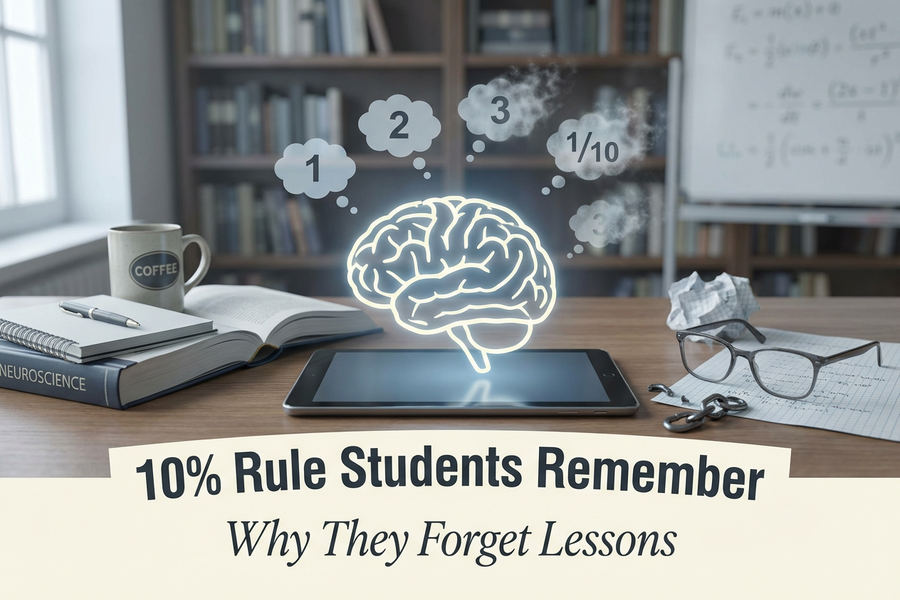Many students study for hours, revise again and again, and still forget most of what they read the next day. This is where the 10% Rule Students Remember becomes important. The idea behind this rule explains why students naturally retain only a small portion of what they study when they use passive learning methods. Understanding this concept helps students learn smarter and remember more with less effort.
The human brain is powerful, but it follows certain rules when processing and storing information. If those rules are ignored, forgetting happens quickly—even when students work hard. This blog explains why the 10% Rule Students Remember affects learning and how students can overcome it using simple, science-backed techniques.
APA article on how memory works.
1. Understanding the 10% Rule Students Remember
The 10% Rule Students Remember, this comes from learning research that shows students recall only about 10% of information when they rely on passive study methods such as reading, listening, or highlighting without engagement. Passive learning activates only a small part of the brain, so information remains in short-term memory and fades quickly.
The brain has two key memory systems:
-
Short-term memory, which holds information for seconds or minutes
-
Long-term memory, which stores information for months or years
Passive studying enters short-term memory but fails to move into long-term memory. Because of this, students feel like the chapter “never went into their mind,” even though they read it multiple times.
Distractions worsen this problem. Switching between books and smartphones breaks concentration, and every interruption resets the brain’s focus. Even a silent phone on the table drains attention. Without steady focus, the brain cannot store information deeply.
2. Why Students Forget Most of What They Study
Students often mistake familiarity for understanding. When they read a chapter again, it “feels” familiar, so they assume they remember it. But the brain only remembers what it works hard to retrieve, not what it simply rereads. This is why the 10% Rule Students Remember affects so many learners.
There are several reasons for forgetting:
Passive learning
Reading without interaction does not build strong memory pathways.
No active recall
Students reread instead of testing themselves. Rereading feels easy, but it does not create long-term memory.
Lack of spaced revision
If students revise only once, the brain quickly forgets. Spaced repetition is essential.
Distractions and multitasking
Notifications break memory formation.
Poor sleep
The brain stores memories during sleep. Without proper rest, learning stays weak.
No real-world connection
When concepts don’t feel meaningful, the brain doesn’t store them deeply.
Understanding these reasons helps students change the way they study and overcome the 10% Rule.
3. The Science Behind Improving Study Memory
Memory grows stronger when the brain actively participates. Techniques that require mental effort improve retention far better than passive learning. These include active recall, spaced repetition, teaching others, and writing notes by hand.
Active recall
This technique forces the brain to retrieve information without looking at notes. Retrieval strengthens neural pathways and moves information from short-term to long-term memory.
Spaced repetition
The brain remembers better when learning is spread out. A simple pattern—reviewing after 24 hours, then after 7 days, and again after 30 days—can increase retention dramatically.
Teaching others
Explaining concepts helps students identify gaps and understand deeply.
Handwritten notes
Writing by hand activates more brain regions than typing or highlighting.
Real-life connection
When students relate concepts to daily life, the brain stores them more effectively.
These methods help break the 10% Rule and build strong, durable memory.
4. Practical Ways to Overcome the 10% Rule
Students can easily increase retention with simple, daily habits. Here are the most effective strategies:
Study for 30 minutes, recall for 10 minutes
After reading, students should close the book and summarise the content. This boosts retention quickly.
Follow the 24-7-30 revision cycle
-
Review within 24 hours
-
Review after 1 week
-
Review after 1 month
This schedule tells the brain the information is important.
Remove distractions
Keeping the phone away increases focus. Even silent notifications weaken memory formation.
Sleep 7–8 hours
Sleep converts new learning into long-term memory.
Solve questions instead of rereading
Problems force the brain to apply knowledge.
Make real-world connections
Linking concepts to practical examples improves recall.
Use handwritten notes
Writing slows down the brain and improves understanding.
These habits can increase retention from 10% to 80% or more.
5. Moving From 10% Retention to 90% Retention
Students do not need to study more hours. They need to study in a way the brain understands. A simple routine can transform memory:
-
Study actively for short sessions.
-
Test yourself without looking at notes.
-
Revise using spaced repetition.
-
Limit distractions during study time.
-
Sleep well to support memory formation.
-
Solve practice questions regularly.
-
Connect concepts to daily life.
When students follow these steps, the 10% Rule Students Remember becomes easy to overcome. Their memory becomes stronger, their confidence increases, and studying feels less stressful and more productive.
Final Thoughts
Students often believe they have weak memory, but the real issue is usually the method of studying. The 10% Rule Students Remember shows that passive learning does not work. The brain learns better when it is active, engaged, and focused.
By using active recall, spaced repetition, teaching techniques, handwritten notes, real-life connections, and distraction-free study time, students can remember far more than they ever thought possible. Learning becomes faster, deeper, and more enjoyable.
Studying smarter—not harder—is the key to beating the 10% Rule.
Also read: The Silent Epidemic: Academic Burnout in Indian Students

